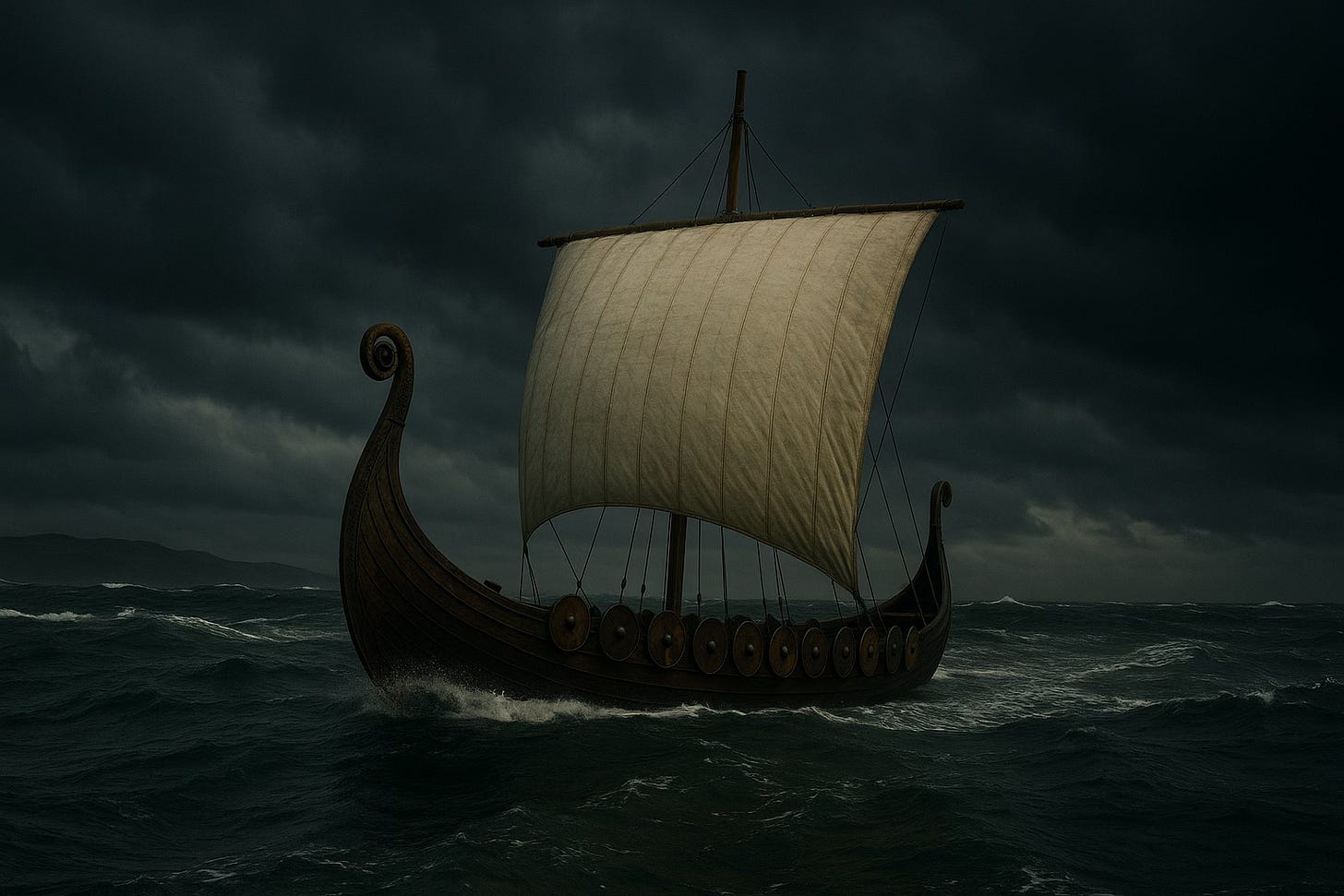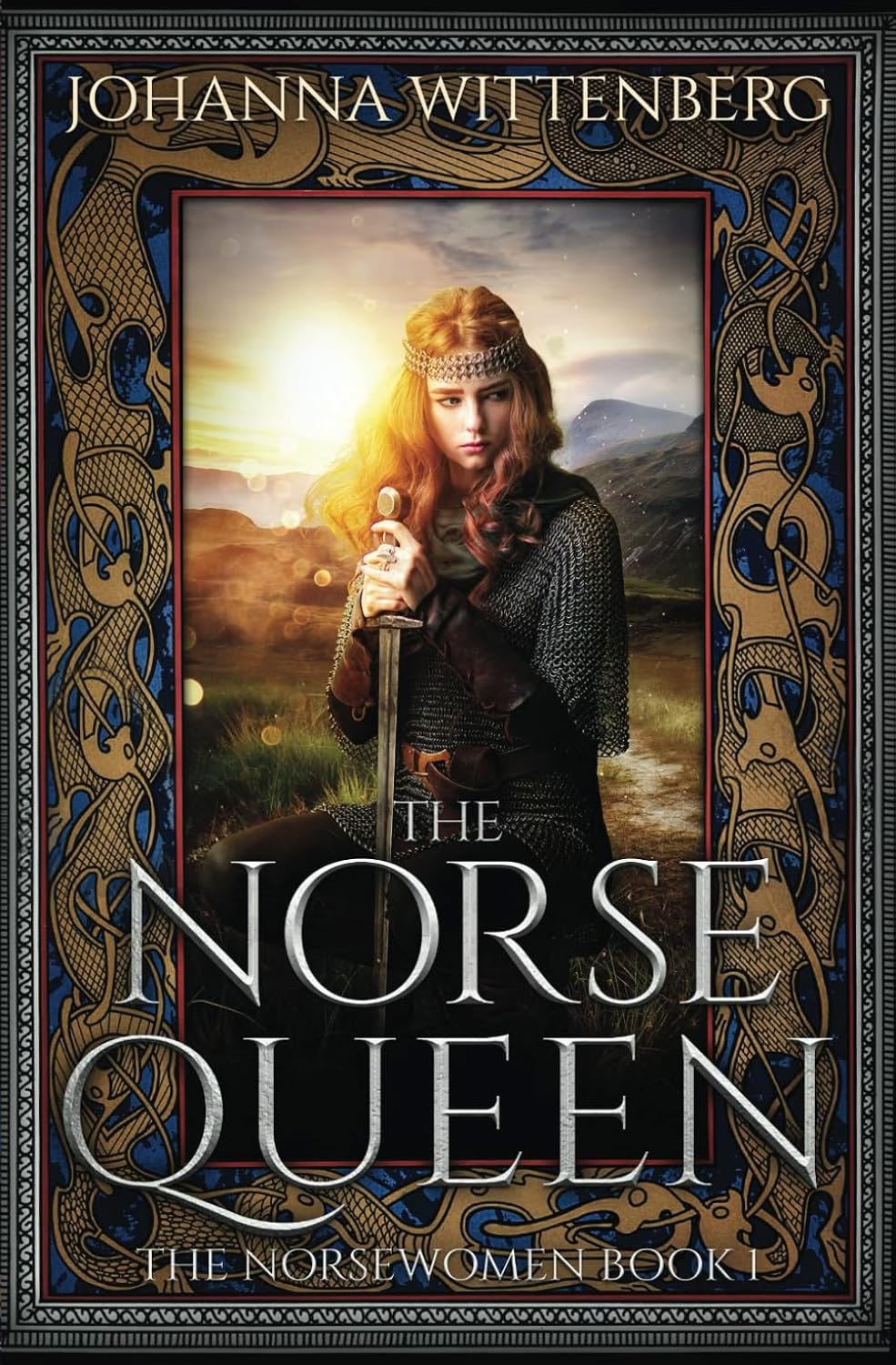Revisited: How fast were Viking longships?
On Viking Longship Speeds (Again) | Vinci Books Relaunch
Welcome to the newsletter, where history, storytelling, and inspiration come together. Every week, I share some of the fun historical research or concepts I’ve encountered while writing my novels (and other things), as well as updates on my work and journey. If you were forwarded this message, you can join the weekly newsletter here.
Today’s Dispatch
Viking History: How fast were Viking longships? Revisited.
Author Update: Vinci Books Relaunch.
This week’s book recommendation.
Viking History
How Fast Did the Vikings Really Sail? Revisited.
This week, I’ve been writing a new chapter that involves long-distance travel—a harrowing sailing trip from Constantinople to Gibraltar—and as always, I’ve ended up down the same rabbit hole: how long should this journey take?
I’ve written about this topic before (How Fast Were Viking Longships?), but today I thought I would dive deeper into all the little things that would have affected their speed and the duration of Viking voyages.
The truth is, for all our reconstructions and experiments, the answer isn’t a simple one. Modern tests with reconstructed ships have shown us that the longship was, indeed, an astonishingly efficient design—the ‘speedboat’ of their day, if you will. But the speed tests that demonstrated this to us were tightly controlled and in specific conditions. In real-world journeys, the average speed recorded by longships has shown that they may not have exceeded the average for other vessels of the day by much.
The Viking Ship Museum in Roskilde has built several longships based on archaeological finds. In one real-world trial, their crew sailed fifty nautical miles across the Danish archipelago. They averaged 4 knots. That’s a far cry from the 13–17-knot top speeds often quoted from short bursts under ideal conditions. In practical terms, it means a day’s journey under sail may not have exceeded 30 nautical miles, depending on wind, current, and crew endurance.
When I write, I take these details into account. Suppose Hasting and his crew are crossing the Mediterranean in summer. In that case, I’ll start by tracing their most plausible route on a map, measuring the distance in nautical miles, and then factoring in average wind directions and weather for that time of year. If it’s winter, then I change the conditions.
Next comes the human reality—because these voyages were ultramarathons, not sprints (unless they’re being chased, which is an important detail). Crews had to rest, repair things, and resupply. On coasting journeys, I imagine they would have sailed no more than nine to ten hours a day, camping on shore each night. A ten-hour day is a long day at sea! And if they were camping on land at night, some of that sailing time would have been eaten up by sailing in and out of camping sites.
Longer stretches over open water were another matter entirely: days without rest, shared shifts, and the ever-present risk of storms or being becalmed.
All of this means that a voyage that looks like a quick hop on a map could have taken weeks longer than simply dividing the distance by an average speed would suggest. And yet, it’s this constraint that gives the journey texture. When you know your characters can’t simply “sail through the night,” you begin to imagine the dangers they may have faced to find a place to get a little shuteye.
Of course, it would be an awfully boring novel indeed if I stayed bogged down in the nightly routine of a crew on a two or three-month journey. That’s the balance I’m always chasing in my novels: historical realism grounded in the evidence, but written with the heart of an adventure story.
If you enjoy that kind of detail—the marriage of archaeology, history, and storytelling—you’ll find plenty of it in my Saga of Hasting the Avenger series. The newest volume, The Empress and Her Wolf, takes Hasting from the glittering palaces of Byzantium to the windswept coasts of the Eastern Mediterranean. Each mile of the journey is imagined as faithfully as history allows.
Author Update
The Vinci Books Re-Launch, Explained
Since announcing that a publisher in the U.K. picked up my Saga of Hasting the Avenger series, I’ve received some questions from readers about what to expect moving forward. It will indeed be a major transition that will change a few things, so I thought it would be a good idea to lay out the upcoming 60, 90, and 180-day plans, and beyond, for my followers.
The first thing to address is creative control and future volumes. Major publishers have a reputation for changing things for authors without their approval. While Vinci’s contract allows them to do so, it also includes strict conditions on when and how that happens, and it’s always done collaboratively with the author. That was part of their pitch to me—that I’d maintain creative control. Even better, I get to continue working with my current editor.
The process for releasing new books, however, will differ from how I handle it now. Once I submit a finished book to Vinci, it will go through their launch process, which takes about three months. Now that I can write full-time, I can establish a rhythm in which I work on the next novel in the series while the previous one is launching. If everything goes well, this could speed up my output. In practice, it will take about 60 days to work with my editor to finalize the manuscript, and then Vinci will take roughly 90 days to launch it. So, if I do this right, you should see a new novel every 90 to 120 days.
The next step is the rebrand. Vinci will completely rebrand the series, with new covers, formatting, and more. While I did a great job on my own, they have a team of top industry professionals, including Stuart Bache from Hodder & Stoughton and HarperCollins, to overhaul everything and prepare it for the big stage. The new covers should be ready in 60 days, and I will share them with you once they are ready. This overhaul will set the stage for a re-launch first in ebook format within 90 days, followed by a trade paperback with global distribution within nine months.
Here’s the kicker: the trade paperbacks will be available in pretty much every kind of store that sells books, including airports!
Last but not least, the series will be translated into ten different languages and sold in over 80 countries. The timeline for this is about nine months, just like the trade paperbacks in English. So, by next summer, you’ll be able to find my books pretty much everywhere in one of ten languages. Fun, right?!
I hope this information helps those of you who were wondering. I have nine books planned for Hastings’ life, and thanks to Vinci, I’m almost sure to finish them all much sooner than I expected.
Book Recommendations
The Norse Queen, by Johanna Wittenberg
Blurb:
Ninth-century Norway, the dawn of the Viking era, -- a land shattered into thirty warring kingdoms. A woman could seize power if she were bold enough. Daughter of a Norse king, fifteen-year-old Åsa dreams of becoming a shieldmaiden. When she spurns a powerful warlord, he rains hellfire on her family, slaughtering her father and brother and taking her captive. To protect her people, Åsa must wed her father’s killer. To take vengeance, she must become his queen.
My take:
Johanna Wittenberg’s The Norse Queen is an enthralling dive into the life of Asa, a historical figure from the legendary Yngling dynasty. Asa, married to Gudrod the Hunter, is a powerful and compelling protagonist whose story is beautifully woven with rich detail and vivid imagination.
As someone who has always been fascinated by the Yngling dynasty, particularly through the Ynglinga Saga, this book was an absolute delight to read. Wittenberg’s portrayal of Asa and Gudrod brings them to life in ways that feel fresh yet deeply rooted in history. Having included some of their earlier characters, including Asa and Gudrod, in my own works, it was exciting to explore their story through a different creative lens.
This first in the series promises even more to come, and I can’t wait to see where Wittenberg takes these legendary figures next. Highly recommended for fans of historical fiction and Norse sagas.







Having worked for a wooden sail-training ship for four years in the 1980s, I can appreciate how difficult it is to average out speed under sail (and we had lots more of it on the One and All than a single-masted Viking ship!) Of course, when you are compelled to have engines as well, one can always make up for lost time due to light wins. I can imagine there were times when Viking voyagers were well and truly "becalmed" if the weather was unseasonable. - Kerry
Just want to say congrats for your deal with a publisher! And the idea that your work will be translated in so many languages is (good) bonkers!